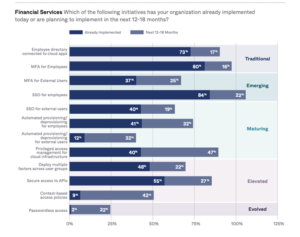
No matter where you turn, everyone seems to be talking about artificial intelligence (AI) right now. Recent revolutions like ChatGPT have taken the tech industry by storm, unlocking previously unimagined possibilities — and a plethora of new fears about privacy, compliance, and security.
Considering the average cost of a data breach was around $4.4 million in 2022, organizations can’t risk a lapse in their security practices — especially with technology evolving at the current rate. For cybersecurity experts, advancements in AI are both a blessing and a curse. While these professionals can use AI as part of their security practices, they must also protect their business from bad actors relying on it, too.
Whether working with or against AI, its ongoing development will reshape how businesses approach security.
How AI Can Boost Cybersecurity
When it comes to security, time is money. Each day a data breach goes undetected can cost a company thousands or even millions of dollars. While AI can be the engine behind these attacks, the positive here is that business leaders can also harness AI to protect their company and their customers.
According to IBM research, organizations with an AI program can identify and contain a breach 28 days faster than those that don’t, which can save them more than $3 million per breach. As fraud becomes more sophisticated, humans will have to rely more heavily on AI to detect and investigate suspicious activity.
One of the biggest areas AI can play a role is in authentication. With so much of our activity happening online, businesses need a way to verify a person is who they say they are and not a bad actor hiding behind the anonymity of a screen. Not only that, but with the development of harmful technology like deepfakes, it’s harder than ever to identify what’s genuine.
3 Ways to Use AI for Authentication
There are a few key areas where AI can be a valuable asset to an organization’s authentication methods.
1. User identity: Businesses have implemented a variety of methods to ensure users are who they say they are. Many of the standard practices include passwords and security questions, but the problem with these is that they’re easy for fraudsters to obtain. Companies can skip the passwords and verify users with biometric authentication, which uses AI to confirm a user’s identity on any device through a selfie, fingerprint, or voice recognition. Considering it requires unique biological characteristics that must be confirmed in real time, biometric authentication ensures the user is present when a transaction occurs.
The recent development of generative AI poses an important question here: What is preventing AI from recreating a biometric that could be used for authentication? The answer is liveness detection, a technique used to detect spoof attempts. Using liveness detection, AI distinguishes between digital or artificially created images and sounds presented on a device and those captured in the moment from a physically present person to determine authenticity.
2. Customer behavior: From keystrokes to touchscreen behavior, people are creatures of habit. Businesses can take advantage of these patterns to indicate when someone’s digital activity strays from their typical behavior. AI can be trained to recognize patterns within vast amounts of data that indicate normal and questionable behavior. Based on this, it can determine if a certain behavior fits the pattern or should be flagged as a potential threat. AI will continue to learn user behavior over time, which will improve its accuracy in detecting fraudulent behavior as the model ingests more data.
3. Authentic documents: Bad actors will sometimes produce or steal counterfeit documents to gain access to valuable information, known as document spoofing fraud. For example, fraudsters may find an image of someone’s driver’s license, passport, or birth certificate or even create a fake one to “prove” they are the person they’re pretending to be. In the era of generative AI, IDs can be created in seconds. Fraudsters today no longer have to go out and steal information; they can use AI to do it for them.
On the other side of the coin, though, AI can also validate documents within seconds to confirm their authenticity, picking up on suspicious features that might go unnoticed by the human eye. Even though fraudsters will continue to find ways to use AI to harm businesses and their customers, organizations don’t have to fear the development of this technology. According to the Association of Certified Fraud Examiners (ACFE), in 2022, nearly 60% of anti-fraud professionals expected their technology budgets to increase in the next two years — and AI should be on their radar.
Using AI to Prevent Fraud’s Impact
Every business leader knows that fraud has a huge bottom-line impact, and preventing it remains a top priority. As companies navigate how to protect themselves from the onslaught of increasingly sophisticated fraud threats, AI will be a critical piece of next-gen authentication. By harnessing its power and using it to authenticate activity, organizations can combat the fraud threats of today and ensure they’re staying one step ahead of them.
- SEO Powered Content & PR Distribution. Get Amplified Today.
- PlatoData.Network Vertical Generative Ai. Empower Yourself. Access Here.
- PlatoAiStream. Web3 Intelligence. Knowledge Amplified. Access Here.
- PlatoESG. Automotive / EVs, Carbon, CleanTech, Energy, Environment, Solar, Waste Management. Access Here.
- BlockOffsets. Modernizing Environmental Offset Ownership. Access Here.
- Source: https://www.darkreading.com/endpoint/3-ways-ai-could-improve-authentication
- :has
- :is
- :not
- :where
- $3
- $UP
- 2022
- 28
- a
- About
- access
- According
- accuracy
- activity
- actors
- ADvantage
- against
- ahead
- AI
- also
- amounts
- an
- and
- Anonymity
- answer
- anti-fraud
- any
- approach
- ARE
- areas
- around
- artificial
- artificial intelligence
- Artificial intelligence (AI)
- AS
- asset
- Association
- At
- Attacks
- Attempts
- Authentic
- authenticate
- Authentication
- authenticity
- Bad
- based
- BE
- becomes
- behavior
- behind
- between
- Biggest
- biometric
- biometric authentication
- blessing
- boost
- both
- breach
- Budgets
- business
- businesses
- but
- by
- CAN
- captured
- certain
- certificate
- Certified
- characteristics
- ChatGPT
- Coin
- combat
- comes
- Companies
- company
- compliance
- Confirm
- CONFIRMED
- considering
- contain
- continue
- Cost
- could
- Counterfeit
- create
- created
- critical
- Current
- customer
- customer behavior
- Customers
- Cybersecurity
- data
- data breach
- day
- Days
- detect
- Detection
- Determine
- Development
- device
- digital
- do
- document
- documents
- dollars
- don
- driver
- each
- Engine
- ensure
- ensures
- Era
- especially
- Even
- EVER
- everyone
- evolving
- example
- expected
- experts
- eye
- fake
- faster
- fear
- fears
- Features
- few
- Find
- fingerprint
- flagged
- For
- fraud
- fraudsters
- fraudulent
- from
- Gain
- generative
- Generative AI
- genuine
- Go
- Goes
- Happening
- harder
- harm
- harmful
- Harnessing
- Have
- heavily
- here
- How
- How To
- HTTPS
- huge
- human
- Humans
- IBM
- identify
- Identity
- ids
- if
- image
- images
- Impact
- implemented
- important
- improve
- in
- include
- increasingly
- indicate
- industry
- information
- Intelligence
- investigate
- IT
- ITS
- jpg
- Key
- Key Areas
- leader
- leaders
- LEARN
- License
- like
- Liveness
- longer
- many
- Matter
- May..
- methods
- might
- million
- millions
- model
- moment
- money
- more
- much
- must
- Navigate
- nearly
- Need
- New
- next
- no
- normal
- now
- of
- on
- ONE
- ongoing
- online
- only
- onslaught
- or
- organization
- organizations
- Other
- our
- out
- over
- part
- passport
- Passwords
- Pattern
- patterns
- People
- per
- person
- Physically
- piece
- plato
- Plato Data Intelligence
- PlatoData
- Play
- plethora
- poses
- positive
- possibilities
- potential
- power
- practices
- present
- presented
- prevent
- preventing
- previously
- priority
- privacy
- Problem
- produce
- professionals
- Program
- protect
- Prove
- question
- Questions
- radar
- Rate
- RE
- real
- real-time
- recent
- recognition
- recognize
- rely
- relying
- remains
- requires
- right
- Risk
- Role
- s
- Save
- say
- Screen
- seconds
- security
- seems
- selfie
- should
- side
- So
- Someone
- sophisticated
- standard
- Step
- Storm
- suspicious
- Take
- taken
- talking
- tech
- tech industry
- Technology
- technology budgets
- than
- that
- The
- their
- Them
- themselves
- These
- they
- this
- those
- though?
- thousands
- threat
- threats
- Through
- time
- to
- today
- too
- top
- trained
- transaction
- TURN
- two
- typical
- unique
- unlocking
- use
- used
- User
- users
- uses
- using
- VALIDATE
- Valuable
- variety
- Vast
- verify
- Voice
- was
- Way..
- ways
- What
- What is
- when
- which
- while
- WHO
- will
- with
- within
- working
- years
- You
- zephyrnet











